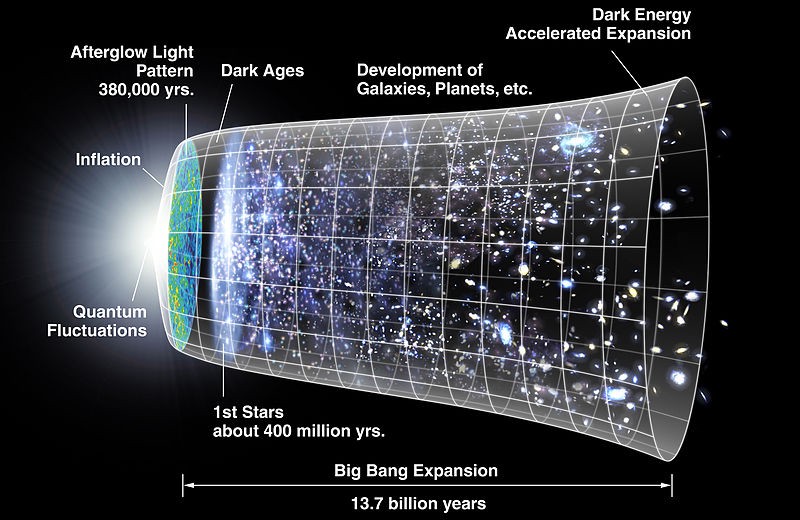The Creation has fascinated me since childhood, growing up with a mainline midwestern Protestant Sunday School education and a closet agnostic physicist/engineer father. Our dinnertable discussions in the 1950s and 1960s ranged to infinity and back, to the edges of the Universe and back, and to what we could know. To me, it all has to make sense together or something is amiss. The Creation – biblical and astrophysical – is where it comes together.
I didn’t have the vocabulary for it, then, but now I do. Mixing an omnipotent deity with the discipline of scientific inquiry opens a door to chaos – which has its value in the intensity of discussion that ensues. And there are lessons to be gleaned, even when disputants slam the door and walk/run away.

He said, “This Big Bang thing is rubbish. You can’t get something from nothing.”
Dad wouldn’t have let me get away with an assertion of “can’t” nor of “impossible”, which may be one reason an assertion like this from a friend might keep me awake at night. Sigh.
So, what do we know and what can we know about the Beginning of the Universe?
Between Steven Weinberg’s The First Three Minutes (1979), which fascinated me then, and the vast trove of information now available online, I have tried to bring myself up to date and distill the essence into simple concepts.
Because no one was present in the Beginning to observe and record, we rely on physical observations we can make today repeatedly to construct a model describing what appears to have happened. We then challenge that model with the observations we have made. We continue coming up with new observations, tweaking the model, and challenging it again – until some unsought observation surprises us and we revise or scrap the model and apply all the old challenges again. The current iteration is called the Standard Model in particle physics.
The most recent calculated age of the Universe is about 13.8 billion (1.38 x 1010) Earth years. At that point, something changed in the conditions at hand, and changes continue today. We call that point “the Beginning“.
We don’t know exactly what the conditions were prior to the change – that is, what changed? If nothing was present, then some further step is necessary to provide the Something that changed at the Beginning.
On one hand, the Universe’s origin was incomprehensibly small, on dimensions much tinier than the smallest known subatomic particles, and it was completely transformed over an immeasurably brief period, much shorter than any observable time scale. On the other, the densities and temperatures were extraordinarily large, far exceeding anything existing in the present-day Universe.
Center for Astrophysics (Harvard & Smithsonian) https://www.cfa.harvard.edu/big-questions/what-happened-early-universe Accessed 11 September 2023
Whatever was present responded to the change by disintegrating into fragments exploding in all directions, thus allowing the temperature to fall and space to be filled with particles carrying matter and energy moving away from its center. The cloud of fragments was so dense that particles collided and interacted with each other, changing characteristics and direction, and moving along to collide again.
As a visual approximation, Prince Rupert’s Drop could stand in for the primordial Something, in which case snipping its tail would be the change — filmed at 100,000 frames per second: Mythbusters and Prince Rupert’s Drop video
Those earliest particles included photons, electrons, neutrinos, and quarks, among others. Together they carried all the mass, energy, charge, spin, and force for interaction that make up the Universe today – the jury is still out on what carries the force of gravity, though of course it’s there.
It could be said that process of expanding, encountering, changing, and moving along continues today. The Universe is much larger now; the temperatures and densities are much lower; and gravity slows the speed of expansion by drawing particles together.
The Big Bang usually refers to the disintegration in all directions of that which changed. Often the literature speaks of it as involving the bigger pieces, the composite particles that resulted from encounters among elementary particles, and even atoms and molecules resulting from more complex encounters. Some articles refer to it as Inflation or Cosmic Inflation.
In a billionth of a trillionth of a trillionth of a second, the Universe grew by a factor of 1026, comparable to a single bacterium expanding to the size of the Milky Way.
[IBID]
Whatever it was called, by 10-33 seconds after the Beginning, the explosive expansion was complete and the Universe contained a mixture of elementary particles, composite particles, protons and neutrons composed of 3 quarks each, and some atomic nuclei composed of protons and neutrons. The temperature had fallen with the expansion, but it was still too hot and crowded for electrons to stay with any atomic nuclei they encountered.
The more I learn about All That Is and about all we have learned about how it came to be, the less need I see for an external omnipotent Power to do anything more than provide the primordial something and, maybe, to give it a push to start. All that is here, now — the Gods that are real, personal, and important to us — have been with us from the Beginning.


